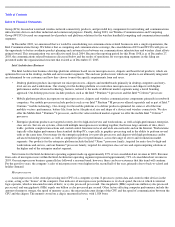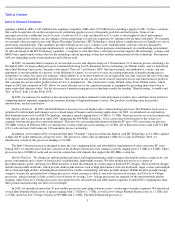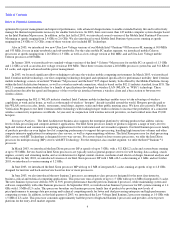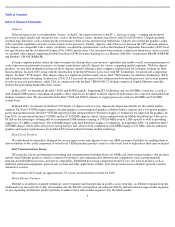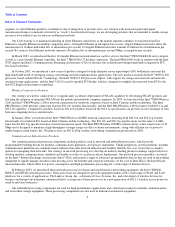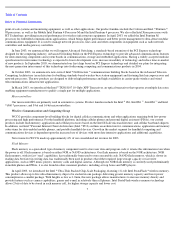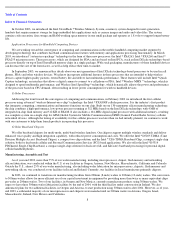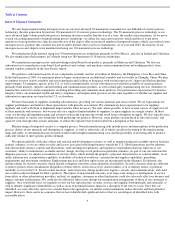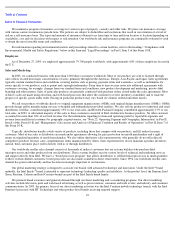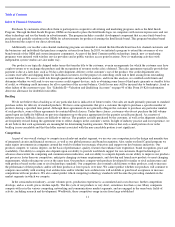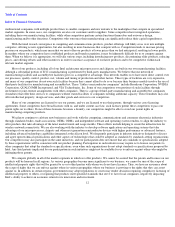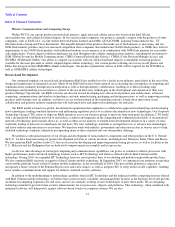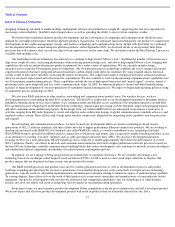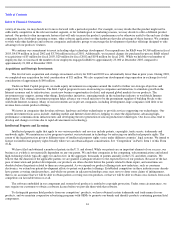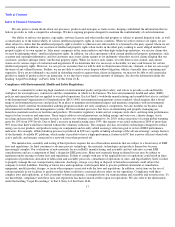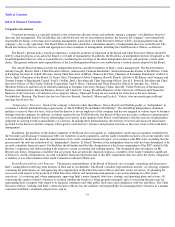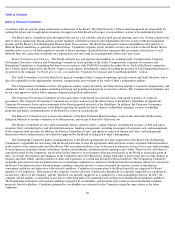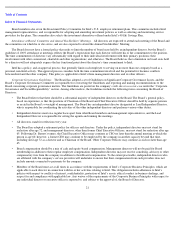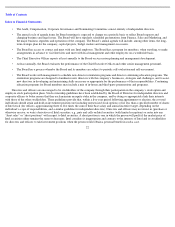Intel 2003 Annual Report Download - page 15
Download and view the complete annual report
Please find page 15 of the 2003 Intel annual report below. You can navigate through the pages in the report by either clicking on the pages listed below, or by using the keyword search tool below to find specific information within the annual report.
Table of Contents
Index to Financial Statements
multinational companies with multiple product lines to smaller companies and new entrants to the marketplace that compete in specialized
market segments. In some cases, our competitors are also our customers and/or suppliers. Some competitors have integrated operations,
including their own manufacturing facilities, while other competitors perform certain functions themselves and outsource design,
manufacturing and/or other functions. Competitors who outsource their manufacturing can significantly reduce their capital expenditures.
With the trend toward convergence in computing and communications products, product offerings will likely cross over into multiple
categories, offering us new opportunities, but also resulting in more businesses that compete with us. Competition tends to increase pricing
pressure on our products, which may mean that we must offer our products at lower prices than we had anticipated, resulting in lower profits.
In markets where our competitors have established products and brand recognition, it may be inherently difficult for us to compete against
them. When we believe it is appropriate, we will take various steps, including introducing new products, discontinuing older products, reducing
prices, and offering rebates and other incentives in order to increase acceptance of our latest products and to be competitive within each
relevant market segment.
Most of our products, including all of our Intel architecture microprocessors and chipsets, are built in our own manufacturing facilities,
although a substantial portion of ICG’s manufacturing is performed by third-party manufacturers. We believe that our network of
manufacturing facilities and assembly/test facilities gives us a competitive advantage. This network enables us to have more direct control over
our processes, quality control, product cost, volume and timing of production and other factors. These types of facilities are very expensive,
and many of our competitors do not own such facilities because they cannot afford to do so or because their business models involve the use of
third-party facilities for manufacturing and assembly/test. These “fabless semiconductor companies” include Broadcom Corporation, NVIDIA
Corporation, QUALCOMM Incorporated, and VIA Technologies, Inc. Some of our competitors own portions of such facilities through
investment or joint-venture arrangements with other companies. There is a group of third-party manufacturing and assembly/test companies
(foundries) that offer their services to companies without owned facilities or companies needing additional capacity. These foundries may also
offer intellectual property, design services, and other goods and services to our competitors.
Many of our competitors are licensed to use our patents, and we are licensed to use their patents, through various cross-licensing
agreements. Some competitors have broad licenses with us, and under current case law, such licenses permit these competitors to pass our
patent rights on to others. If one of these licensees becomes a foundry, our competitors might be able to avoid our patent rights in
manufacturing competing products.
We plan to continue to cultivate new businesses and work with the computing, communications and consumer electronics industries
through standards bodies, trade associations, OEMs, ODMs, and independent software and operating system vendors, to align the industry to
offer products that take advantage of the latest market trends and usage models. These efforts include helping to create the infrastructure for
wireless network connectivity. We are also working with the industry to develop software applications and operating systems that take
advantage of our microprocessors, chipsets and other next-generation semiconductor devices with higher performance or advanced features,
including advanced technology capabilities integrated at the silicon level. We frequently participate in industry initiatives designed to discuss
and agree upon technical specifications and other aspects of technologies that could be adopted as standards by standards-setting organizations.
Our competitors may also participate in the same initiatives, and our participation does not ensure that any standards or specifications adopted
by these organizations will be consistent with our product planning. Participation in such initiatives may require us to license our patents to
other companies that adopt the standards or specifications, even when such organizations do not adopt standards or specifications proposed by
Intel. Any Intel patents implicated by our participation in such initiatives might not be available for us to enforce against others who might be
infringing those patents.
We compete globally in all of the market segments in which we offer products. We cannot be assured that the patents and licenses on our
products will be honored in all regions. As various geographies become more significant to our business, we cannot be sure of the scope of
intellectual property rights that will be granted to us or to third parties with whom we do not have licenses. Thus, we have no assurance about
the scope of rights that we can enforce against others in various geographies where our business is growing or the rights that they can assert
against us. In addition, in certain regions, governments may adopt regulations or courts may render decisions requiring compulsory licensing of
intellectual property to others, or requiring that products meet specified standards that serve to favor local companies, negatively impacting
Intel’s ability to achieve an economic return for its innovation and investment.
12


